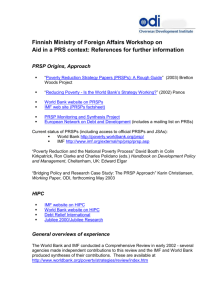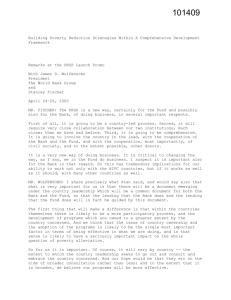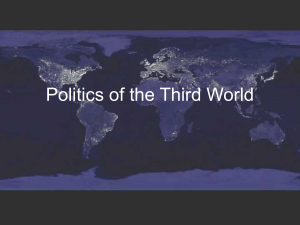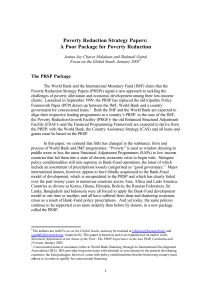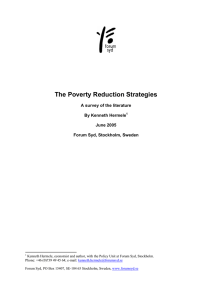Poverty on the agenda?
advertisement
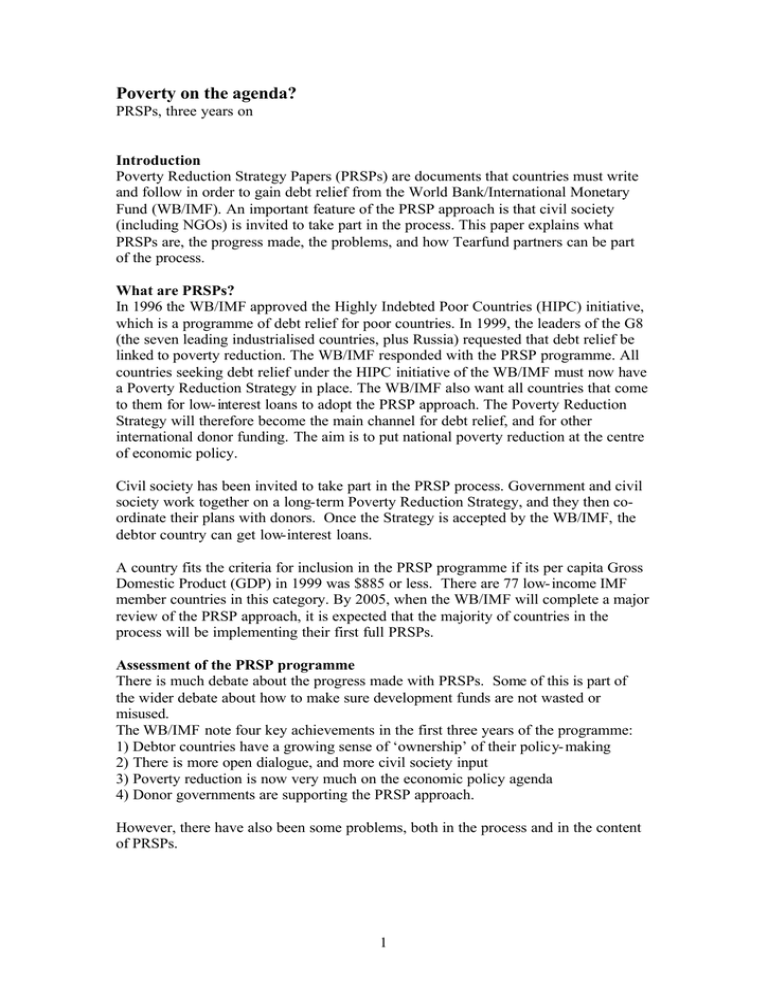
Poverty on the agenda? PRSPs, three years on Introduction Poverty Reduction Strategy Papers (PRSPs) are documents that countries must write and follow in order to gain debt relief from the World Bank/International Monetary Fund (WB/IMF). An important feature of the PRSP approach is that civil society (including NGOs) is invited to take part in the process. This paper explains what PRSPs are, the progress made, the problems, and how Tearfund partners can be part of the process. What are PRSPs? In 1996 the WB/IMF approved the Highly Indebted Poor Countries (HIPC) initiative, which is a programme of debt relief for poor countries. In 1999, the leaders of the G8 (the seven leading industrialised countries, plus Russia) requested that debt relief be linked to poverty reduction. The WB/IMF responded with the PRSP programme. All countries seeking debt relief under the HIPC initiative of the WB/IMF must now have a Poverty Reduction Strategy in place. The WB/IMF also want all countries that come to them for low- interest loans to adopt the PRSP approach. The Poverty Reduction Strategy will therefore become the main channel for debt relief, and for other international donor funding. The aim is to put national poverty reduction at the centre of economic policy. Civil society has been invited to take part in the PRSP process. Government and civil society work together on a long-term Poverty Reduction Strategy, and they then coordinate their plans with donors. Once the Strategy is accepted by the WB/IMF, the debtor country can get low-interest loans. A country fits the criteria for inclusion in the PRSP programme if its per capita Gross Domestic Product (GDP) in 1999 was $885 or less. There are 77 low- income IMF member countries in this category. By 2005, when the WB/IMF will complete a major review of the PRSP approach, it is expected that the majority of countries in the process will be implementing their first full PRSPs. Assessment of the PRSP programme There is much debate about the progress made with PRSPs. Some of this is part of the wider debate about how to make sure development funds are not wasted or misused. The WB/IMF note four key achievements in the first three years of the programme: 1) Debtor countries have a growing sense of ‘ownership’ of their policy- making 2) There is more open dialogue, and more civil society input 3) Poverty reduction is now very much on the economic policy agenda 4) Donor governments are supporting the PRSP approach. However, there have also been some problems, both in the process and in the content of PRSPs. 1 1. How can a country begin to own its PRSP if a PRSP is a requirement for debt relief? The WB/IMF have said that when they assess PRSPs, they will take account of differing national histories, characteristics and drafting processes. However, PRSPs from countries with very different circumstances are remarkably similar. Many PRSPs have been shaped to meet WB/IMF requirements. In some cases, drafts have been written by WB/IMF staff. NGOs have rarely been asked to share in major economic policy decisions because governments know the WB/IMF have already made up their minds and will not agree to different policies. We would support safeguards that help to ensure debt relief is spent on poverty reduction and is not stolen by the governing élite. These should strengthen public confidence. However, continued WB/IMF control of national macroeconomic policy will weaken ownership of PRSPs by governments. Strengthening national ownership will mean the WB/IMF limiting their own power and allowing national governments more freedom to make decisions. 2. Governments have hurried to write their PRSPs, at the expense of quality. The WB/IMF acknowledge that participating countries have rushed the writing of their PRSPs because the process is tied to HIPC and much- needed debt relief. The rush may limit participation by the marginalised, who are too poor to spend their time participating at short- notice. The WB/IMF have addressed this rush by making substantial debt relief available on presentation of a short, interim PRSP. However, governments are not required to involve civil society in drawing up an interim PRSP. When civil society participates in the writing of the full Strategy, they often find that governments are unwilling to change too much of the interim PRSP. The solution suggested by the United Nations is that debt relief under the HIPC initiative should not be tied to the PRSP. To guard against misuse of debt relief money it should be channelled to an independent body and not to the government. 3. The level of participation There is much debate about the extent to which civil society has been allowed to influence the process. Among those most likely to be excluded are: NGOs out of favour with government, stakeholders outside of capital cities, local government, the private sector, trade unions, women’s groups, and direct representatives of poor people. Some parliaments have even been bypassed (in Senegal, Tanzania, and Bolivia, for example). The two main reasons for exclusio n are the unwillingness of some government departments to include civil society, and the limited capacity of many NGOs. Governments often limit participation to the middle stages of the process. NGOs may be asked to comment on a first draft of a PRSP, or contribute ideas to the main areas. But they rarely take part in setting the agenda, writing the final draft, or monitoring/evaluation. The larger, better-resourced NGOs with advocacy experience, have been better able to take part, and more ready to challenge their exclusion. Smaller NGOs and community groups may be much less able to contribute to discussion about complex macroeconomic issues and go through thick policy documents. Yet these organisations are often closest to the poor. Their inclusion is a key test of the quality and success of a PRSP programme. Their continued exclusion weakens input into the 2 PRSP process, and reduces public support. It also makes poor people objects in the process when they should be subjects. Although governments often ignore what NGOs say, many Tearfund partners have found participation in the PRSP process worthwhile. It has helped them learn about the workings of government. They have been encouraged because NGO involvement in the process means they are valued. They have formed alliances with other NGOs, and gained experience in working with them. For the future, capacity-building (of parliaments and NGOs), perhaps with financial help from the WB/IMF, would seem to be a fruitful way forward. 4. Information flows are key. Good participation depends on good information flows – ‘downwards’ from government to NGOs and to poor people, ‘upwards’ to government, and also horizontally across government departments, NGOs and poor people. Too often key documents have been ava ilable only in countries’ official language, and sometimes only in English. The problem is made worse by the use of jargon and abbreviations. There is a need to help people understand how government institutions work, and how policy processes are organised. Details of contact names and sources of further information should be readily available. The media, especially radio, can play a valuable role. NGOs, too, should be channelling information, and consulting often with poor people, to ensure they really are representing their views. 5. Lack of coordination between donors has made planning difficult for governments One of the most positive aspects of the PRSP concept is the potential for closer alignment of development policies. The WB’s ‘Country Assistance Strategy’ (the document showing its input into a country’s development programme) will normally be based on the PRSP. It is hoped that the IMF will base its lending programme, the ‘Poverty Reduction and Growth Facility’ (PRGF), on PRSPs. Then, in turn, the PRSP needs to be aligned with other national strategies, such as strategies for education, and for reproductive health care. The links between these issues (for example, the impact of education on health outcomes) need to be understood. The PRSP must also take account of major cross-cutting issues, such as HIV/AIDS, disaster management, and the environment. Often, these key causes of poverty are covered badly, or not at all. The content of PRSPs: key issues There are some generally recognised weaknesses in the PRSPs written so far. These include failure to set priorities, simplistic action plans, poverty data that is out-of-date, and weaknesses in budgeting and auditing systems. There is also a tendency to deal with the symptoms rather than the underlying causes of poverty. National economic policy and poverty issues The strong involvement of the WB/IMF, and the lead role taken by Ministries of Finance, has meant that PRSPs prioritise macroeconomics (such as interest rates and inflation targets) over social spending. The WB/IMF firmly believe that poverty will only be reduced through economic growth, and that growth is achieved through removing the barriers to the free market. This might include: restricting the money supply in order to reduce inflation, selling off publicly owned businesses such as telecommunications and water supply, removing controls on the prices of staple 3 goods, and opening up to foreign direct investment. However, this free market strategy might not lead to poverty reduction: In order to balance their budgets, governments may cut social expenditure. This hurts poor people because users of health and education services are asked to pay fees. The WB/IMF’s solution is that governments should assess the problem (through poverty and social impact analysis), and then help the poorest with the payment of fees. Poverty is in fact one of the main obstacles to growth. The poor lack access to loans and assets, so they cannot properly contribute to economic growth. There appears to be a link between greater openness to trade and falling incomes among the poorest 40 per cent of the population (Lundberg and Squire, 1999). Privatisation of utilities such as electricity and water supply may mean lost jobs and higher prices. It is argued that privatisation encourages efficiency and reduces corruption, but this does not always happen. High debt repayments may also limit economic growth. The repayment of legitimate debt is very important, but it should come second to the provision of those essential human needs (primary health care, safe water and sanitation, primary education) which foster growth. Inequality An important issue that PRSPs do not address is action to tackle inequality. In order to halve poverty by 2015, a country with a wide gap between rich and poor would have to grow economically twice as fast as a country with a narrow gap (Hammer et al, 2000). This is clearly impossible. Improving health, education and infrastructure will narrow the gap between rich and poor, but more direct action is needed For example: reallocating the ownership of productive resources such as land (this issue seems to have been avoided in PRSPs so far, apart from clarifying ownership rights), redistributing unfair tax burdens, e.g. value added tax (VAT) hits the poor hardest, focusing on basic human rights e.g. ensuring the poor can get legal help to defend their rights, tackling child labour, addressing the concentration of political power, improved labour rights, and public spending which targets the poor. How to get involved NGOs have been calling for more civil society involvement in policy- making for a long time. The WB/IMF have responded with the PRSP, which seems to be an open invitation for active NGO participation. Although there are problems with the process, a positive response from NGOs may mean that the move to greater civil society involvement in policy- making becomes irreversible. The advantages in Tearfund and partners responding are: a) The PRSP includes valuable poverty analysis. It is good sense to make use of it. b) If Tearfund and partners know what is in the national poverty strategies, they can align their own work with them. If key concerns are left out (e.g. disaster management and prevention, integrated water mana gement) Tearfund and partners can lobby for their inclusion. 4 c) The PRSP process is a golden opportunity for Tearfund and partners to widen their influence through linking up with similar NGOs and churches, and to gain advocacy experience. How, then, can Tearfund regional teams and their partners get involved? a) Refer to the IMF website and find out what your country has so far produced. It may have produced an interim PRSP (I-PRSP), and a report on how far it has got with the full PRSP (the Presentatio n Status report). Some countries have already produced full PRSPs, or their own poverty action plan has been accepted by the WB/IMF as a substitute. One or two countries have already been implementing their PRSPs, and have produced progress reports. b) If the interim/full PRSP has already been prepared, find out what is in it. It should be on the IMF website. What assessments have local or international NGOs made? Consider what you might contribute to the debate. For example, you may have local knowledge of a particular region or poverty issue. You might have the ability to monitor progress through household or user surveys of key indicators (e.g. school attendance). c) Find out if there is a national NGO forum participating in the PRSP process. Ask at the local government offices, the finance ministry, the national evangelical alliance, or the council of churches. If national churches or the evangelical alliance have been asked to participate it may be possible for you to participate through them. d) Track PRSP reviews – e.g. the review undertaken by the WB/IMF in 2002 (see the WB/IMF websites). Further information PRSP documents can be accessed on the World Bank/IMF websites (www.worldbank.org, www.imf.org) Analysis and reports can be found on two important NGO websites: the Bretton Woods Project (www.brettonwoodsproject.org), and Eurodad (www.eurodad.org) For UK and EU responses to the PRSP programme see the websites of the Department for International Development (www.dfid.gov.uk) and the European Union (www.europa.eu.int) Eurodad or Jubilee Research (www.jubileeresearch.org) may be able to help link Tearfund partners with southern NGO networks World Vision International has published a book entitled ‘Masters of their own development? PRSPs and the Prospects for the Poor’ (edited by Alan Whaites, ISBN 1-887983-40-6) Order from World Vision (www.worldvision.org.uk) For general help on advocacy see Tearfund’s Advocacy Toolkit and the Tearfund International Learning Zone website (www.tilz.info) Bryan R Evans, Public Policy Team, November 2002 5

